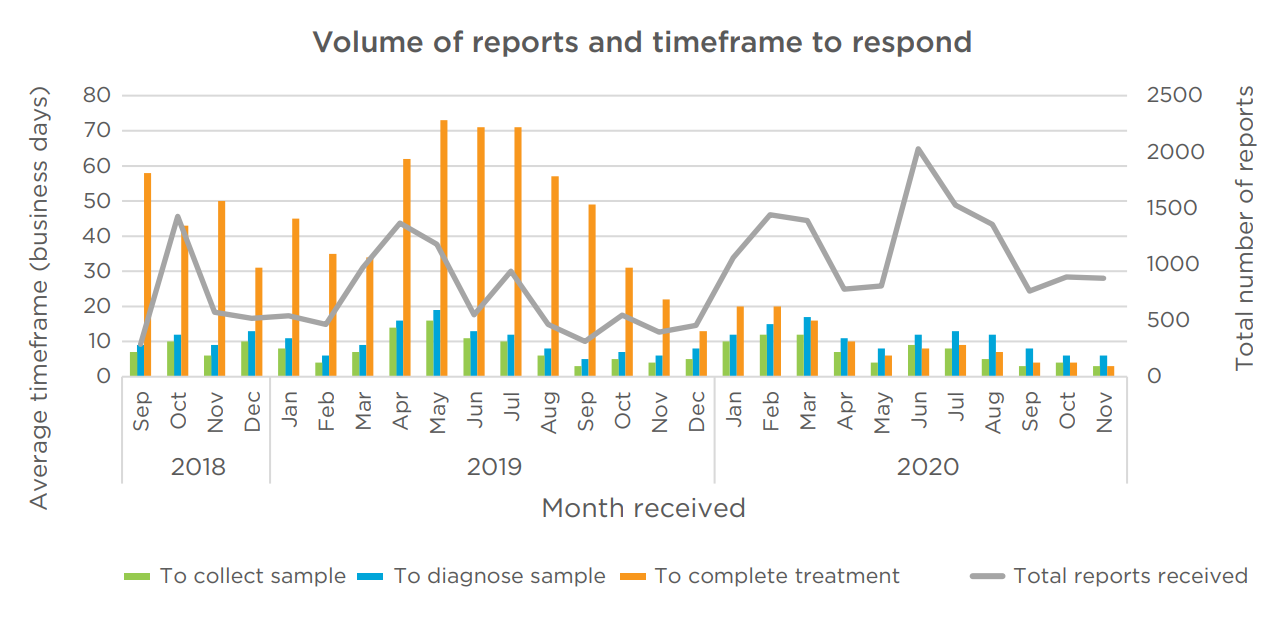The Queensland Ombudsman has investigated the timeliness of the National Red Imported Fire Ant Eradication Program’s responses to notifications of suspected fire ant locations made by members of the public. This program operates under Biosecurity Queensland within the Department of Agriculture and Fisheries.
Background on the fire ant program
Under the Biosecurity Act 2014, members of the public must report suspected fire ant locations to Biosecurity Queensland. The National Red Imported Fire Ant Eradication Program uses these reports as an information source about the location and movement of fire ants, the accuracy of the operational area boundaries and the success of previous, planned treatments.
Why did the Ombudsman undertake an investigation?
The Ombudsman responded to concerns about the speed of response to notifications from the public about suspected fire ant locations.
In scope
The Ombudsman’s investigation assessed the timeliness of responses to reports made by members of the public about suspected fire ant locations.
Out of scope
The investigation did not:
- Assess the effectiveness of the program’s overall approach to eradicating fire ants
- Conduct scientific analysis of the treatment methods.
What did the Ombudsman find?
The Ombudsman’s investigation looked at information about how the program responds to reports from the public.
Analysis of the program’s data identified that the average time to complete treatment improved significantly throughout 2020. In the 12-month period, September 2018 to September 2019, monthly average time to treat fire ants was greater than 40 days for nine months. However, time to complete treatment dropped from late 2019 and throughout 2020. This was despite a surge in reports received in February and June 2020. The average time to complete treatment is now consistently less than 10 days.
The investigation identified two changes that significantly contributed to the improvement in timeframes:
- Use of new type of treatment (a fast-acting bait, Indoxacarb)
- An organisational restructure and revised administrative processes.

Introduction of fast-acting bait
In September 2019, the program altered its treatment protocol to allow the use of a fastacting bait, Indoxacarb. Previously, direct nest injection (DNI) was the only treatment method used for all confirmed reports of fire ants. The introduction of Indoxacarb meant that a final treatment can be applied at the time of sample collection and during the first attendance by a program team.
Organisational restructure
In early 2020, the program restructured the operational teams, which streamlined the process for receiving and responding to public reports of fire ants. This improved the response timeframe, and also improved the service by allowing officers who assess and triage reports to liaise directly with field officers.
In early 2021, the program introduced a new field-based digital data entry capability. This capability enables field officers to directly enter data into the electronic database while in the field. These digital enhancements have enabled the program’s resources to be deployed in a more efficient manner.
Was this reasonable?
The Ombudsman’s investigation considered whether action to shorten response times supported adequate treatment of fire ant activity.
The program’s Treatment Protocol provides guidance on when treatment should occur and what method should be used. The appropriateness of DNI or Indoxacarb treatment is dependent on:
- An assessment of risk to public health and safety
- The location of the report in relation to the operational boundary and treatment areas
- The nature of the job site (i.e. number of nests reported, access restrictions and size of site to be treated).
DNI is the program’s preferred approach to treatment and is used where operationally suitable. The program has assessed the use of Indoxacarb, including reviews of studies on its efficacy and the environmental variables. Scientific evidence supports the program’s use of DNI and Indoxacarb as methods of treatment.
The Ombudsman found use of DNI and Indoxacarb was reasonable in the circumstances and these treatment options contributed significantly to the improvement in timeframes for response to reports of fire ant locations.
What changes did the Ombudsman recommend?
The investigation identified two opportunities for further improvement to current oversight mechanisms. It was recommended that the Director-General of the department should:
- Include a quality assurance mechanism to monitor:
- Triage and assessment decisions of notifications of suspected fire ants from the public so that appropriate feedback or systemic change can be actioned<
- The input of data by field officers on treatment completion (managing the transition of this responsibility from the data entry team to field officers).
- Consider an audit tool to monitor the appropriateness of the treatment method applied considering the characteristics of the particular job site. This could mitigate the risk that the continued need to maintain timeliness could result in over-reliance on less effective treatment methods.
The Department of Agriculture and Fisheries has advised the Ombudsman that it accepted the recommendations.
Why has the Ombudsman published this summary?
This investigation was conducted under the Ombudsman Act 2001.
Maintaining appropriate confidentiality is an essential part of the Office’s work. Section 92 of the Ombudsman Act sets specific requirements for disclosure of information in the conduct of Ombudsman investigations. Under s 54 of the Ombudsman Act, the Speaker of the Queensland Parliament may authorise the Ombudsman to publish a report, in the public interest, about any particular case investigated by the Ombudsman.
The Ombudsman considers it is in the public interest to confirm that an investigation has been completed. The investigation found the National Red Imported Fire Ant Eradication Program has improved its timeliness in responding to notifications of suspected fire ant activity. Further improvements in quality assurance and auditing have been recommended.
The Speaker has consented to the publication of this report.